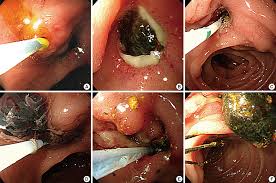
Gallstones are a common problem in the general population and commonly cause problems with pain (biliary colic) and gallbladder infections (acute cholecystitis).
Gallstones can sometimes migrate out of the gallbladder and become trapped in the tube between the gallbladder and the small bowel (common bile duct). Here, they obstruct the flow of bile from the liver and gallbladder into the small bowel and cause pain, jaundice (yellowish discolouration of the eyes, dark urine, and pale stools), and sometimes severe infections of the bile (cholangitis).
Treatment involves removal of the gallbladder as well as the gallstones from this tube. There are several methods to achieve this. Surgery is performed to remove the gallbladder. Newer keyhole techniques (laparoscopic surgery) are now the most common methods of removal of the gallbladder.
Alternatively, an endoscope (a narrow flexible tube equipped with a camera) is inserted through the mouth and into the small bowel to allow removal of the trapped gallstones from the common bile duct.